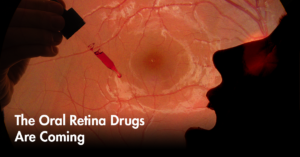Six Oral Retina Drug Development Programs to Watch
 Intravitreal anti-vascular endothelial growth factor (VEGF) therapy slows or stops damage that occurs in wet age-related macular degeneration (AMD), diabetic retinopathy (DR), and other retinal diseases. Although regular anti-VEGF injections have become the standard of care, they come with notable patient and physician burden.
Intravitreal anti-vascular endothelial growth factor (VEGF) therapy slows or stops damage that occurs in wet age-related macular degeneration (AMD), diabetic retinopathy (DR), and other retinal diseases. Although regular anti-VEGF injections have become the standard of care, they come with notable patient and physician burden.
Because of the invasive nature of anti-VEGF therapy, “the majority of patients do not come to the clinic on a regular basis,” says retina specialist and key opinion leader Raj Agrawal, MD, MS, VP for clinical development and ophthalmology lead at Rezolute, and founder of the nonprofit Retina Global, which brings retinal treatments to underserved patients worldwide. “We also know almost 50% of diabetic macular edema patients do not respond well to anti-VEGF,” Dr. Agrawal says.
Reducing or eliminating the number of injections needed for treatment would alleviate some patient burden and potentially improve compliance. To meet this need, drug developers are working on a number of alternatives, including anti-VEGF agents that require less-frequent dosing, topical treatments, gene therapy, and oral treatments.
Of the latter, several clinical-stage biopharma companies have products moving through early-phase clinical trials, among them oral therapies.
“Because patients can take oral medications at home instead of coming to the clinic every time to get an injection, there is a higher chance of patient compliance, which will likely reflect in better disease control and better visual acuity outcomes,” says Dr. Agrawal.
Here are six oral retina therapies at various stages of development.
AKST4290 (Alkahest)
Formerly known as ALK 4290, AKST4290 is a twice-daily oral inhibitor of the chemokine C-C motif receptor 3 (CCR3) that blocks the action of eotaxin, an immunomodulatory protein that increases as humans age and contributes to specific age-related diseases. By targeting eotaxin and its downstream effects, AKST4290 may reduce the hallmark inflammation and neovascularization of AMD while also acting more broadly to reduce inflammation associated with many other age-related diseases.
Parallel Phase IIa studies in newly diagnosed, treatment-naive patients with wet AMD showed improvement in best-corrected visual acuity (BCVA) with no severe or serious adverse events reported.
Alkahest initiated a Phase IIb clinical trial, PHTHALO-205 (n = 107, NCT04331730) in early 2020 to evaluate efficacy on visual acuity after three loading doses of aflibercept in treatment-naive wet AMD patients. A readout is forthcoming.
ALK-001 (Alkeus Pharmaceuticals)
Alkeus is studying ALK-001 in both dry AMD and Stargardt disease. An oral modified form of vitamin A, ALK-001 is designed to slow the formation of toxic vitamin A aggregates, or “dimers,” which contribute to these diseases.
A Phase II/III trial (n = 300, NCT03845582) of ALK-001 for geographic atrophy (GA) secondary to dry AMD is under way with an estimated completion in mid-2023. Alkeus is also conducting a Phase II trial (n = 140, NCT02402660) to examine the safety, tolerability, and effectiveness of ALK-001 in patients with Stargardt disease.
LBS-008 (Belite Bio)
Belite Bio describes LBS-008 as a first-in-class oral, small-molecule, retinol-binding protein 4 (RBP4) specific antagonist for dry AMD. LBS-008 reduces the amount of circulating vitamin A, thereby reducing uptake in the eye, which purportedly prevents the formation of toxins associated with dry AMD and Stargardt disease.
Results of a Phase I trial (n = 71, NCT03735810) confirmed safety and tolerability and that oral administration achieved potentially therapeutic-level target engagement. Belite Bio says it has completed enrollment in a Stargardt disease trial and recently launched a global Phase III trial for Stargardt disease. It expects to enter Phase III for dry AMD in 2022.
Xiflam (OcuNexus Therapeutics)
Xiflam is an oral small-molecule agent that blocks connexin43 (Cx43) hemichannels that have been shown to be overexpressed in exudative retinal disease. The compound was developed 20 years ago and evaluated for migraine treatment, but development was halted due to a company merger.
Now in the hands of OcuNexus, the compound is being studied in DME, wet AMD, and GA. An animal study showed promising data for diabetic retinal disease treatment, and the company reports a “significant effect” on protecting retinal structure in a phenotypical model of GA.
RZ402 (Rezolute Bio)
RZ402, a once-daily oral therapy, targets the kallikrein–kinin system to address the inflammation and vascular leakage that are known to play a significant role in diabetic macular edema. RZ402 inhibits plasma kallikrein, thereby blocking downstream bradykinin production and the complications that lead to DME.
A Phase Ia single-ascending dose study showed RZ402 was safe and well-tolerated at all doses, with no significant adverse events. The company launched a Phase Ib single-center, randomized, double-blind, placebo-controlled multiple-ascending dose study in healthy volunteers in August. Dr. Agrawal, who is leading the study, says Rezolute plans to complete the study with data by early 2022. A Phase II study is planned also for 2022.
More to Come
The oral retina therapy innovation space doesn’t stop there. Oxurion has moved its candidate, THR-149, through to Phase IIb study. KalVista Pharmaceuticals is in the early stages of developing an oral plasma kallikrein inhibitor, while Tyrogenix stopped its Phase II study of X-82, an oral vascular endothelial growth factor inhibitor, due to toxicity concerns. Provided some of these therapies move successfully through later-stage clinical trials, the lives of retina specialists and patients may get a whole lot easier.
